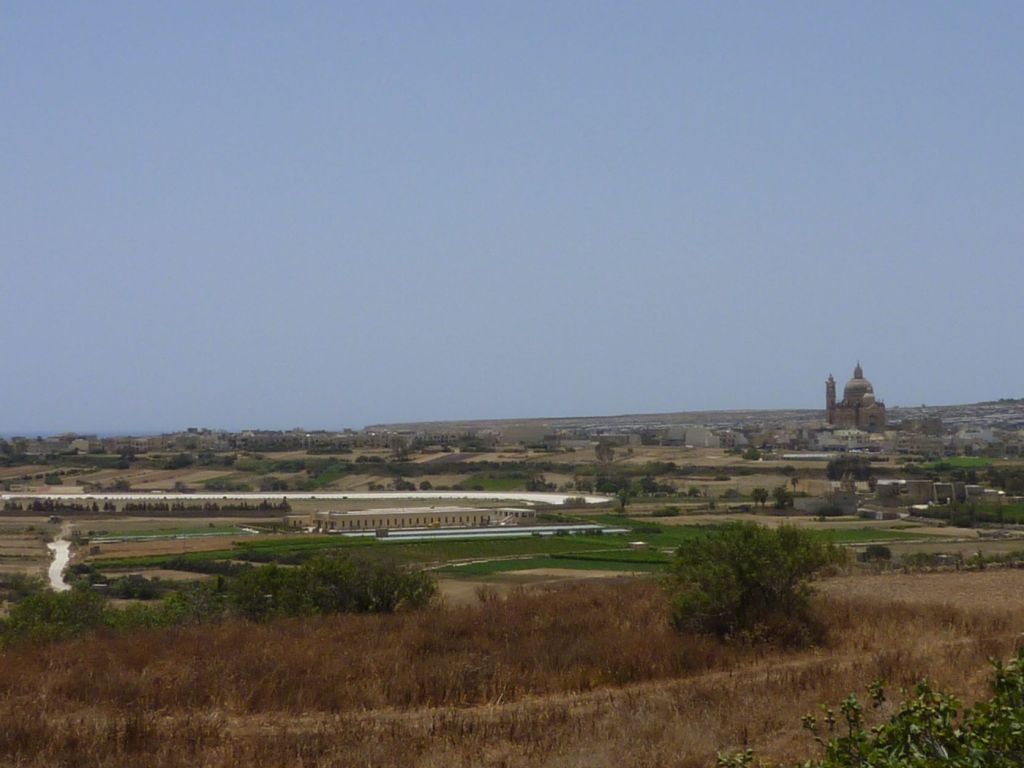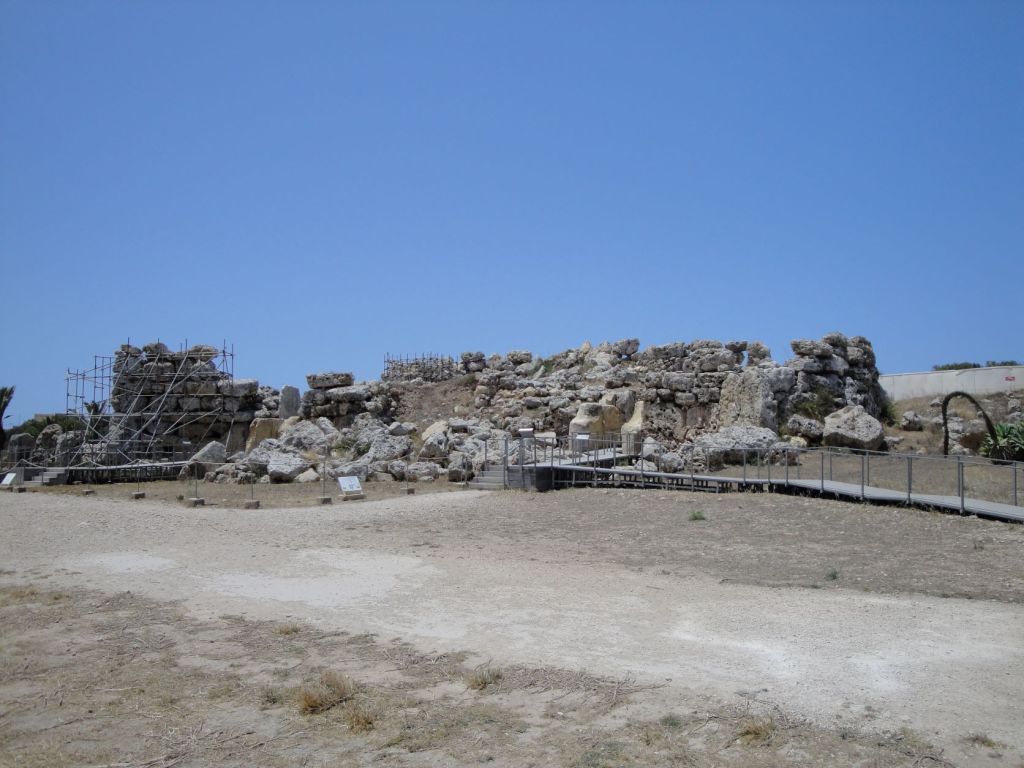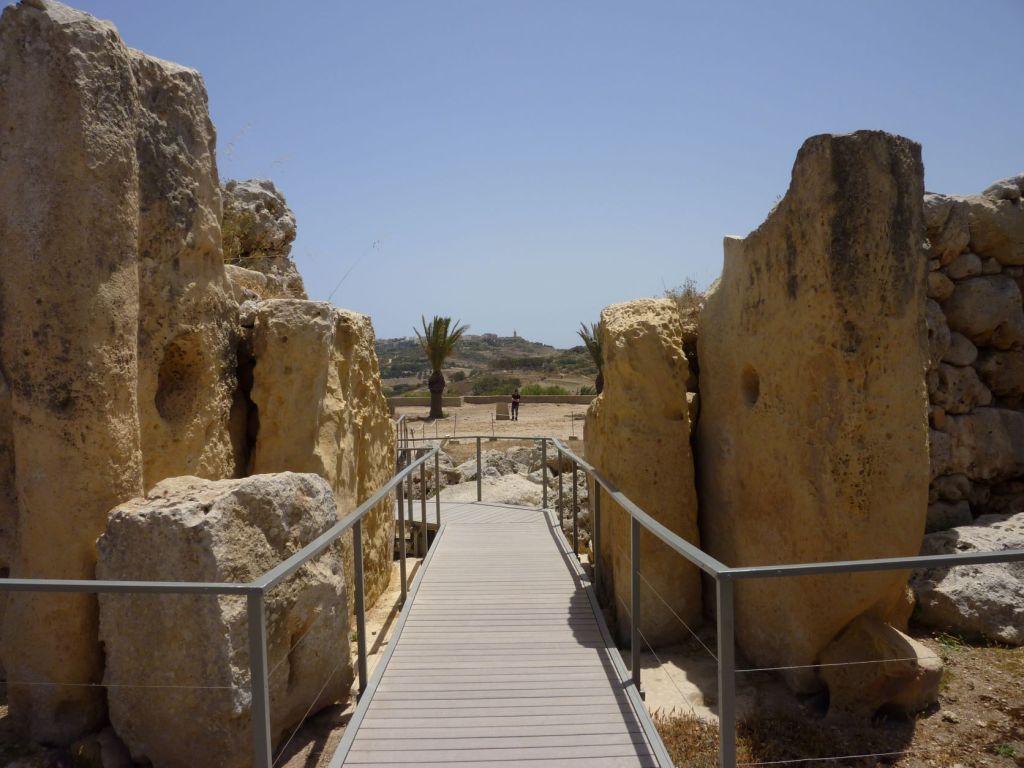GOZO – GGANTIJA TEMPLES
Only 3.5km (2.1 miles) from Gozo’s capital city Victoria, is the ancient Ggantija Temples – awesome for its age, its engineering and for the mystery of its builders.

Experts say the Ggantija temples were built between 3600 and 3200 BC. Ggantija is claimed to be the world’s oldest free-standing structure – older even than the Egyptian pyramids and Stonehenge in Britain.

The Ggantija or, as it was commonly known in the past, “The Giant’s Tower”, is the largest, the best preserved and by far the most impressive prehistoric temple. It was unearthed in 1827 and comprises two temples, built several centuries apart with a forecourt.



According to legend, the massive blocks of Ggantija were carried from the south side of the island by a female giant between 3600 and 3000 BC – some of these slabs are as much as 6m (20ft) high and weigh many tons.
I was wondering about this statement … in the first place, so there were giants? And secondly, why would it be a female giant? I guess this is a story to figure out at another time …







The huge megaliths forming the outer wall (the largest weighing several tons) were built alternately – one horizontally and one upright.

It was fascinating to walk around these ancient temple sites, while life (as we know it today) a few steps further, were carrying on as normal. There was a farmer just on the other side of the wall busy harvesting his onions … it was actually quite weird to witness.


While walking around at the site of the Ggantija Temples, you can’t help but have your imagination stimulated by the thought of the ancient age of this place and what type of people lived here centuries ago.

Well, I suppose sometimes a heap of stones could be the representation of something with much more meaning and history than I could have ever thought.
In our next post about Gozo – yes, there are still more to show – we will visit the delightful little seaside village of Xlendi where we’ve stayed for our weekend on Gozo.
We have done these trips in 2011 & 2013













Thank you for the tour around the ancient temples of Gozo. We only visited Victoria so it’s been interesting to learn more about the island. Marion
LikeLiked by 1 person
Thank you Marion for still coming back to continuing reading about our Malta trips – it’s much appreciated! I’m glad you’ve enjoyed this one as well – I was quite impressed with this ancient site (taking into consideration of how old it is) … I’ll never say again “but it’s just a heap of stones” 😀.
LikeLiked by 1 person
Fascinating to visit such an ancient site. To think that they manage to transport these huge slabs of stone without metal tools or the wheel. I am intrigued by the 5 semi-circular apses radiating from the central corridor – what shape does it give to the structure? Thanks for taking us along with you!
LikeLiked by 1 person
It is indeed fascinating – I was completely bowled over by how old these temples are! If you have a look at the first photo (the model of Ggantija Temples) the bigger temple site (with the 5 semi-circular apses) almost looks like a butterfly or plane … well, I suppose from ancient perspective, the probability is a butterfly 🤔.
The smaller one appears like the number eight (8) … like both of us said: Fascinating!
Thanks for (still) following our trips to Malta/Gozo – we’ve got a few more before we round it up with a “Diving in Malta” post!
LikeLiked by 1 person
An interesting post, we also enjoyed this a few years ago when we were in Gozo, incredible that these temples are still standing, fascinating 😊
LikeLiked by 1 person
Great that you also had the opportunity to visit this ancient site – it was really impressive. And I’m sure where you’re now, you are probably seeing more ancient places 😉.
LikeLiked by 1 person
Hard to believe I’ve never heard of these ruins. I am fascinated. There is so much we can only try to imagine!
LikeLiked by 1 person
Absolutely – we’ve never heard of the Ggantija Temples until we’ve arrived in Malta. It was just hard to get my head around the age of this site. Thanks for reading and take care.
LikeLike
It’s so interesting to wander through ruins and try to imagine the splendor that was there at one time. Great photos!
LikeLiked by 1 person
Ah, thank you very much. It was a quite unreal day to walk around this site and try to imagine just how old it is!
LikeLiked by 1 person
I had no idea how much Malta had to offer until I started reading your posts about it. 😀
LikeLiked by 1 person
For such a small island, there’s A LOT to see! And the history behind everything is quite amazing … oh yes, and to get to Sicily, is only a 90 minute ferry ride from Malta 😊. Like you’ve said, Malta’s got so much to offer!
LikeLiked by 1 person
Wow this is absolutely amazing, I read it to Derek and now he has many questions flowing out his mouth… Of course all along the same lines of why a female giant. He of course wanted to see a photo of the giant and wondered why they needed two temples. 😁😜 You must have had a ball.
LikeLiked by 1 person
Well, you can tell Derek that statement about the female giant was a big point of discussion for the whole day! But even over a bottle of wine later that evening we could not come to a any conclusions … Berto’s opinion: A photo of that female giant would’ve been great 😜.
And you’re 100% on the “ball of a time” … it was such an amazing experience – after 8 years, we still talks passionately about our last trip to Malta!
Thanks for stopping by & take care 💌.
LikeLike
Sjoe, dis verskriklik interessant – het nog nooit eers hiervan gehoor nie!
LikeLiked by 1 person
Dit was vir ons net so ‘n groot verrassing om hierdie antieke tempels in Gozo (en Malta) raak te loop … ek dog eers ons gaan net plas in die warm Meditereense See, maar ons het soveel meer gekry!
LikeLiked by 1 person
I’ve only heard amazing things about Malta, we should definitely stop by one day😀
Christie
LikeLiked by 1 person
It will be great to back (again 😉) … I think there’s more we have not seen (or want to see again)! Thanks for stopping by. Corna
LikeLiked by 1 person
I love me a good mystery! These ruins are quite impressive and it’s incredible to think how old they are. It makes you wonder what life must have been like back then.
LikeLiked by 1 person
That’s so true … just the sheer age of these temples are beyond my imagination! It was a great spending some time between these ancient rocks (and if they could only talk … we would be able to find out more about that female giant 😉).
LikeLiked by 1 person
It’s hard to get your head around a building this old, isn’t it?! Those walls are amazing – the technique reminds me of Inca walls but these are so much older!
LikeLiked by 1 person
Yes, it was definitely difficult to comprehend the age of these temples … and how it all happened … and why … and who were these people? Hmm, if these walls could only talk 😉.
LikeLiked by 1 person
Dis so interessant! mal oor klippe!
LikeLiked by 1 person
Beslis ja! ‘n Klip is nie sommer net ‘n klip nie, ne 😊.
LikeLike
Dis verseker 😊😃
LikeLiked by 1 person
Such an interesting site – I love the mystery of it! 🙂
LikeLiked by 1 person
Indeed Hannah! It’s probably the mystery surrounding this site, that makes it that extra amazing 😊.
LikeLike
Ggantija is fascinating – great photos! Malta offers so much for a traveller…
LikeLiked by 2 people
Yes, the Ggantija temples are indeed a fascinating place! And I’m pretty sure – although it’s such a small island – if a big family visit Malta (and Gozo), that there will be something for everyone to see and do!
Thanks for reading – much appreciated!
LikeLike
We visited Gozo 3 years ago.We loved visiting the Ggantija Temples. Went on our own by cab. So much history to see. You have great images.
LikeLiked by 1 person
Oh, that’s great Anita – so glad you’ve also enjoyed your visit at the Ggantija Temples! Yes, you’re absolute right – the history is just mind blowing!
Thanks for your lovely comment 🌸.
LikeLike
Wow it looks amazing. I was born in Malta. I definitely need to visit.
LikeLiked by 1 person
It was such a great trip and we’ve got wonderful memories! Wow, it’s quite amazing that you were born on this pretty Mediterranean island … yes, won’t that be awesome to go back there!
LikeLiked by 1 person
Another great post here, Corna.
For obvious reasons I have had little to do for the last 18 months or so but sit at home (Government diktat) and watch an awful lot of documentaries on the BBC, many of which have been about archaeology. I think that we were all brought up thinking that the humans of 5,000 years ago were little more than apes loving in caves who had mastered a bit of flint-knapping and chucking the results at woolly mammoths or oryx or whatever but the most recent thinking is that they were a lot more “civilised” (if that is the right word for it. This site is a prime example.
The techniques employed here are dry stone walling (still practiced on the outer reaches of the UK and presumably elsewhere) but on steroids, on the grand scale, it is a simply stupendous piece of very ancient architecture. I think it is long past time we regarded our more ancient ancestors as unthinking beasts rather than humans and gave them the credit they deserve. I believe they were a lot more advanced than they are given credit for and your piece here merely adds to my belief.
LikeLiked by 1 person
I totally agree with you on this opinion Fergy! They were clever (and possibly even more hardworking than our lot of these days)! Looking at what’s been accomplish centuries ago, we are definitely underestimate them.
LikeLiked by 1 person
I really do not think that we are quite as smart as we think we are. Look at what our so-called “civilisation” has brought us, a world that is slowly but surely dying. Maybe the ancients had it right all along.
LikeLiked by 1 person